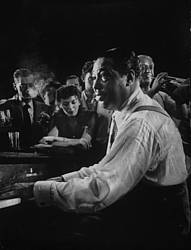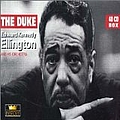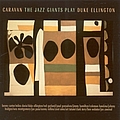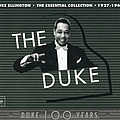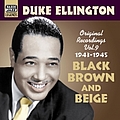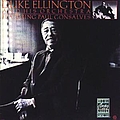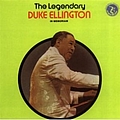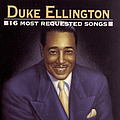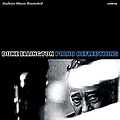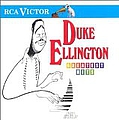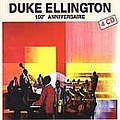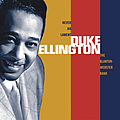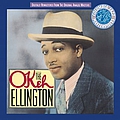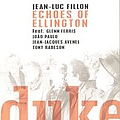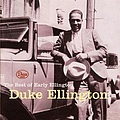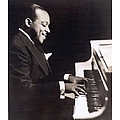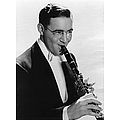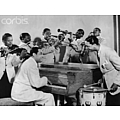Duke Ellington Biography
Duke Ellington (Edward Kennedy Ellington, Washington, D.C., 29 April, 1899 - New York City, 24 May, 1974), was an American jazz composer, pianist, and bandleader. Through the ranks of Duke Ellington's Orchestra passed some of the biggest names in jazz, including Johnny Hodges, Cootie Williams, Bubber Miley, Joe "Tricky Sam" Nanton, Barney Bigard, Ben Webster, Harry Carney, Sonny Greer, Otto Hardwick, Clark Terry, Jimmy Blanton, Ray Nance, Paul Gonsalves, and Wellman Braud. Many musicians stayed with him for decades. And while all of them were remarkable in their own right, and they all would have probably made it into the annals of jazz history no matter who they played for, it was Ellington's genius as a composer, pianist, bandleader, celebrity personality, and, most importantly, arranger, that made them the most incredible orchestral unit in the history of jazz. His ability to write and arrange for personalities, rather than instruments, made every solo and every section of every arrangement breathe with character. A giant on the 20th century American cultural scene, Duke Ellington was widely regarded as a legend during his own lifetime. Early life Edward Kennedy Ellington was born on April 29, 1899 to James Edward Ellington and Daisy Kennedy Ellington. They lived with his maternal grandparents at 2129 Ward Place, NW in Washington, D.C. James Edward Ellington was born in Lincolnton, North Carolina on April 15, 1879 and moved to Washington, D.C. in 1886 with his parents.[4] Daisy Kennedy, was born in Washington, D.C. on January 4, 1879, and was the daughter of a former American slave. J.E. made blueprints for the United States Navy. He also worked as a butler for Dr. Middleton F. Cuthbert, a prominent white physician, and occasionally worked as a White House caterer. Daisy and J.E. were both piano players—she playing parlor songs and he operatic airs. At the age of seven, Ellington began taking piano lessons from Mrs. Marietta Clinkscales. Daisy surrounded her son with dignified women who reinforced his manners and taught him to live elegantly. From his father, he absorbed self-confidence. Ellington’s childhood friends noticed that "his casual, offhand manner, his easy grace, and his dapper dress gave him the bearing of a young nobleman", and began calling him Duke. Ellington credited his "chum" Edgar McEntree, "a sharp dresser himself," with the nickname. "I think he felt that in order for me to be eligible for his constant companionship, I should have a title. So he called me Duke."[9] Though Ellington took piano lessons, he was more concerned with baseball. "President Roosevelt (Teddy) would come by on his horse sometimes, and stop and watch us play," he recalled. Ellington went to Armstrong Technical High School in Washington, D.C. He got his first job selling peanuts at Washington Senators’ baseball games where he conquered his stage fright. In the summer of 1914, while working as a soda jerk at the Poodle Dog Café, he wrote his first composition, "Soda Fountain Rag" (also known as the "Poodle Dog Rag"). Ellington created "Soda Fountain Rag" by ear, because he had not yet learned to read and write music. "I would play the 'Soda Fountain Rag' as a one-step, two-step, waltz, tango, and fox trot," Ellington has recalled. "Listeners never knew it was the same piece. I was established as having my own repertoire." In his autobiography, Music is my Mistress, (1973) Ellington comments he missed more lessons than he attended, feeling at the time that playing the piano was not his talent. Over time, this would change. Ellington started sneaking into Frank Holiday's Poolroom at age fourteen. Hearing the poolroom pianists play ignited Ellington's love for the instrument and he began to take his piano studies seriously. Ellington began listening to, watching, and imitating ragtime pianists, not only in Washington, D.C., but also in Philadelphia and Atlantic City, where he vacationed with his mother during the summer months.[citation needed] Dunbar High School music teacher Henry Lee Grant gave him private lessons in harmony. With the additional guidance of Washington pianist and band leader Oliver "Doc" Perry, Ellington learned to read sheet music, project a professional style, and improve his technique. Ellington was also inspired by his first encounters with James P. Johnson and Luckey Roberts, early jazz piano giants. Later in New York he took advice from Will Marion Cook, Fats Waller, and Sidney Bechet. Ellington started to play gigs in cafés and clubs in and around Washington, D.C. and began to realize his love for music. His attachment grew to be so strong that he turned down an art scholarship to the Pratt Institute in Brooklyn in 1916. He dropped out of Armstrong Manual Training School, where he was studying commercial art, just three months shy of graduation. From 1917 through 1919, Ellington launched his musical career, painting commercial signs by day and playing piano by night. Duke's entrepreneurial side came out when if a customer would ask him to make a sign for a dance or party, he would ask them if they had musical entertainment, if not Ellington would ask if he could play for them. He also had a messenger job with the U.S. Navy and State Departments. Ellington moved out of his parents' home and into one which he bought for himself as he became a successful ragtime, jazz, and society pianist. At first, he played in other ensembles, and in late 1917 formed his first group, "The Duke’s Serenaders" ("Colored Syncopators", his telephone directory advertising proclaimed)[citation needed]. He was not only a member, but also the booking agent. His first play date was at the True Reformer's Hall where he took home 75 cents. Ellington played throughout the Washington, D.C. area and into Virginia for private society balls and embassy parties. The band included Otto Hardwick, who switched from bass to saxophone; Arthur Whetsol on trumpet; Elmer Snowden on banjo; and Sonny Greer on drums. The band thrived, performing for both African-American and white audiences, a rarity during the racially divided times.[citation needed] Marriage and family With his career taking off, Ellington felt secure enough to marry his high school sweetheart, Edna Thompson, on July 2, 1918 when he was 19. Shortly after their marriage, on March 11, 1919 Edna gave birth to their only son, Mercer Kennedy Ellington, who went on to play trumpet, lead his own band and work as the road manager of his father's band, eventually taking it over after Duke's death. He was an important archivist of his father's musical life. Ellington's sister, Ruth, later ran Tempo Music, Ellington's music publishing company. Ellington's granddaughter Mercedes is a dancer who has performed in network television productions. Grandson Paul Ellington is a pianist and composer who now leads the Duke Ellington Orchestra. Early career Left: Duke Ellington circa 1950When his drummer Sonny Greer was invited to join the Wilber Sweatman Orchestra in New York City, Ellington made the fateful decision to leave behind his successful career in Washington, D.C. and aspire to the challenge of Harlem. The 'Harlem Renaissance' was in progress. New dance crazes, like the Charleston, were bred there as well as African-American musical theater, including Eubie Blake's Shuffle Along. After the young musicians left the Sweatman Orchestra to strike out on their own, they found an emerging jazz scene that was highly competitive and hard to crack. They hustled pool by day and played whatever gig they could find. The young band met Willie "The Lion" Smith who showed them the scene and even gave them spare cash. They played at rent-house parties to get by. After a few months, the young musicians returned to Washington, D.C. feeling discouraged. But in June 1923, a gig in Atlantic City, New Jersey led to a play date at the prestigious Exclusive Club in Harlem, followed in September 1923 by a move to the Hollywood Club, 49th and Broadway, and a four-year engagement which gave Ellington a solid artistic base. The group was called Elmer Snowden and his Black Sox Orchestra and had seven members, including James "Bubber" Miley, a trumpeter whose growling style changed the "sweet" dance band sound of the group to one that was edgier and hotter. They renamed themselves "The Washingtonians". When Snowden left the group in early 1924, Ellington took over as bandleader. After a fire, the club was re-opened as the Club Kentucky (often referred to as the "Kentucky Club"), an engagement which set the stage for the biggest opportunities in Ellington's life. Ellington made eight records in 1924, receiving composing credit on three including Choo Choo.[12] In 1925, Ellington contributed four songs to Chocolate Kiddies, an all-African-American revue which introduced European audiences to African-American styles and performers. "Duke Ellington and his Kentucky Club Orchestra" grew to a ten-piece organization, developing their distinct sound, displaying the non-traditional expression of Ellington’s arrangements, the street rhythms of Harlem, and the exotic-sounding trombone growls and wah-wahs, high-squealing trumpets, and sultry saxophone blues licks of the band members. For a short time, the great soprano saxophonist Sidney Bechet played with the group, imparting his propulsive swing and superior musicianship on the young band members. This helped attract the attention of some of the biggest names of jazz, including Paul Whiteman. In 1927, King Oliver turned down a regular booking for his group as the house band at Harlem's Cotton Club; the offer passed to Ellington. With a weekly radio broadcast and famous clientèle nightly pouring in to see them, Ellington and his band thrived in the period from 1932 to 1942, a "golden age" for the poor boys from Washington D.C. Trumpeter Bubber Miley was a member of the orchestra for only a short period but had a major influence on Ellington's sound.[citation needed] An early experimenter in jazz trumpet growling, Miley is credited with morphing the band's style from rigid dance instrumentation to a growling 'jungle' style. He also composed most of "Black and Tan Fantasy" and "Creole Love Call". An alcoholic, Miley had to leave the band before they gained wider fame. He died in 1932 at the age of twenty-nine. He was an important influence on Cootie Williams, who replaced him. In 1927 Ellington made a career-advancing agreement with agent-publisher Irving Mills giving Mills a 45% interest in Ellington's future. The brash, shrewd Mills had an eye for new talent and early on published compositions by Hoagy Carmichael, Dorothy Fields, and Harold Arlen. During the 1930s, Ellington's popularity continued to increase, largely as a result of the promotional skills of Mills, who got more than his fair share of co-composer credits. Mills arranged recording sessions on the Brunswick, Victor, and Columbia labels which gave Ellington popular recognition. Mills took the management burden off of Ellington's shoulders, allowing him to focus on his band's sound and his compositions.[citation needed] Ellington ended his association with Mills in 1937, although he continued to record under Mills' banner through 1940. At the Cotton Club, Ellington's group performed all the music for the revues, which mixed comedy, dance numbers, vaudeville, burlesque, hot music, and illegal alcohol. The musical numbers were composed by Jimmy McHugh and the lyrics by Dorothy Fields (later Harold Arlen and Ted Koehler), with some Ellington originals mixed in. Weekly radio broadcasts from the club gave Ellington national exposure. In 1929, Ellington appeared in his first movie, a nineteen-minute all-African-American RKO short, Black and Tan, in which he played the hero "Duke". In the same year, The Cotton Club Orchestra appeared on stage for several months in Florenz Ziegfeld's Show Girl, along with vaudeville stars Jimmy Durante, Eddie Foy, Jr., Al Jolson, Ruby Keeler, and with music and lyrics by George Gershwin and Gus Kahn. That feverish period also included numerous recordings, under the pseudonyms "Whoopee Makers", "The Jungle Band", "Harlem Footwarmers", and the "Ten Black Berries". In 1930, Ellington and his Orchestra connected with a whole different audience in a concert with Maurice Chevalier and they also performed at the Roseland Ballroom, "America's foremost ballroom". Noted composer Percy Grainger was also an early admirer and supporter. In 1929, when Ellington conducted the orchestra for Show Girl, he met Will Vodery, Ziegfeld’s musical supervisor. In his 1946 biography, Duke Ellington, Barry Ulanov wrote: “From Vodery, as he (Ellington) says himself, he drew his chromatic convictions, his uses of the tones ordinarily extraneous to the diatonic scale, with the consequent alteration of the harmonic character of his music, its broadening, The deepening of his resources. It has become customary to ascribe the classical influences upon Duke - Delius and Debussy and Ravel - to direct contact with their music. Actually his serious appreciation of those and other modern composers, came after his meeting with Vodery.” Ulanov, Barry. Duke Ellington, Creative Age Press, 1946. As the Depression deepened, the recording industry took a dive, dropping over 90% by 1933. Ellington and his orchestra survived the hard times by taking to the road in a series of tours. Radio exposure also helped maintain his popularity. Ivie Anderson was hired as their vocalist (Sonny Greer had been providing occasional vocals). Normally, Ellington led the orchestra by conducting from the keyboard using piano cues and visual gestures; very rarely did he conduct using a baton. As a bandleader, Ellington was not a strict disciplinarian but he maintained control of his orchestra for decades to come with a crafty combination of charm, humor, flattery, and astute psychology. A complex, private person, he revealed his feelings to only his closest intimates and effectively used his public persona to deflect attention away from himself. While their United States audience remained mainly African-American in this period, the Cotton Club had a near exclusive white clientèle and the band had a huge following overseas, demonstrated both in a trip to England in 1933 and a 1934 visit to the European mainland. The English visit saw Ellington win praise from members of the "serious" music community, including composer Constant Lambert, which gave a boost to his aspirations to compose longer "serious" pieces. And for agent Mills, it was a publicity triumph, as Ellington was now "internationally famous". On their tour through the segregated South in 1934, they avoided some of the traveling difficulties of African-American musicians by touring in private railcars, which provided easy accommodations, dining, and storage for equipment, while avoiding the indignities of segregated facilities. The death of Ellington's mother in 1935 led to a temporary slump in his career. Competition was also intensifying[citation needed], as African-American and white "Swing Bands" began to rocket to popular attention, including those of Benny Goodman, Tommy Dorsey, Jimmy Dorsey, Jimmie Lunceford, Benny Carter, Earl Hines, Chick Webb, and Count Basie. Swing dancing became a youth phenomenon, particularly with white college audiences, and "danceability" drove record sales and bookings. Jukeboxes proliferated nationwide spreading the gospel of "swing". Ellington band could certainly "swing" with the best of them, but Ellington's strength was mood and nuance, and richness of composition, hence his statement "jazz is music; swing is business". The challenge for Ellington at that time was to create a workable balance between his ceaseless artistic exploration and the popular requirements of that era.[citation needed] Ellington countered with two innovations. He made recordings for smaller groups (sextets, octets, and nonets) drawn from his then 15-man orchestra and he composed pieces that were concerto-like and focused on a specific instrumentalist, as with Jeep's Blues for Johnny Hodges and Yearning for Love with Lawrence Brown. In 1937, Ellington returned to the Cotton Club which had relocated to the mid-town theater district. In the summer of that year, his father died, and due to many expenses Ellington's financial condition was tight. Things improved in 1938 and he met and moved in with Cotton Club employee Beatrice "Evie" Ellis. After splitting with agent Irving Mills, he signed on with William Morris. The 1930s ended with a very successful European tour just as World War II loomed. Ellington delivered some huge hits during the 1930s, which greatly helped to build his overall reputation "Mood Indigo" in 1930, "It Don't Mean a Thing (If It Ain't Got That Swing)" in 1932, "Sophisticated Lady" in 1933, "In a Sentimental Mood" in 1935, "Caravan" in 1937, "I Let A Song Go Out Of My Heart" in 1938. Following shortly were "Do Nothing Till You Hear from Me" in 1940 and "Take the "A" Train" (written by Billy Strayhorn) in 1941. The most important event of Ellington’s “golden age” was the arrival of Billy Strayhorn.[citation needed] Hired as a lyricist, Strayhorn , nicknamed "Swee' Pea" for his mild manner, eventually became a vital member of the Ellington Organization and as Ellington described him, "my right arm, my left arm, all the eyes in the back of my head, my brain waves in his head, and his in mine".[16] Strayhorn, with his Classical music training, applied that knowledge to arrange and polish future Ellington works. Ellington came to rely on Strayhorn's harmonic judgment, discipline, and taste. Duke in the 1940s The band reached a creative peak in the early 1940s[citation needed], when Ellington wrote for an orchestra of distinctive voices and displayed tremendous creativity. In November 1943 Ellington debuted Black, Brown and Beige in Carnegie Hall which told the struggle of African-Americans, and began a series of concerts ideally suited to displaying Ellington's longer works. While some jazz musicians had played at Carnegie Hall before, few had performed anything as elaborate as Ellington’s work. Some of the musicians created a sensation in their own right. The short-lived Jimmy Blanton transformed the use of double bass in jazz, allowing it to function as a solo rather than a rhythm instrument alone. Ben Webster too, the Orchestra's first regular tenor saxophonist, started a rivalry with Johnny Hodges as the Orchestra's foremost voice in the sax section. Ray Nance joined, replacing Cootie Williams who had "defected", contemporary wags claimed, to Benny Goodman. Nance, however, added violin to the instrumental colors Ellington had at his disposal. A privately made recording of Nance's first concert date, at Fargo, North Dakota, in November 1940, is probably the most effective display of the band at the peak of its powers during this period. This recording is one of the first of innumerable live performances which survive, made by enthusiasts or broadcasters, significantly expanding the Ducal discography as a result. Three-minute masterpieces flowed from the minds of Ellington, Billy Strayhorn (from 1939), Ellington's son Mercer Ellington, and members of the Orchestra. "Cotton Tail", "Mainstem", "Harlem Airshaft", "Streets of New York" and dozens of others date from this period. Ellington's long-term aim became to extend the jazz form from the three-minute limit of the 78 rpm record side, of which he was an acknowledged master.[citation needed] He had composed and recorded Creole Rhapsody as early as 1931, and his tribute to his mother, "Reminiscing in Tempo," had filled four 10" record sides in 1935; however, it was not until the 1940s that this became a regular feature of Ellington's work. In this, he was helped by Strayhorn, who had enjoyed a more thorough training in the forms associated with classical music than Ellington. The first of these, "Black, Brown, and Beige" (1943), was dedicated to telling the story of African-Americans, the place of slavery, and the church in their history. Unfortunately, starting a regular pattern, Ellington's longer works were generally not well-received; Jump for Joy, an earlier musical, closed after only six performances in 1941. The first recording ban of 1942-3 had a serious effect on all the big bands because of the resulting increase in royalty payments to musicians. The financial viability of Ellington's Orchestra came under threat, though Ellington's income as a songwriter ultimately subsidized it. Ellington always spent lavishly and although he drew a respectable income from the Orchestra's operations, the band's income often just covered expenses. Meanwhile, the development of modern jazz, or bebop, the music industry's shift to solo vocalists such as the young Frank Sinatra as the Big Band age died out, and the diminishing popularity of ballroom and nightclub entertainment in the early television era all undermined Ellington's popularity and status as a trendsetter.[citation needed] Bebop rebelled against commercial jazz, dance jazz, and strict forms to become the music of jazz aficionados. Furthermore, by 1950 the emerging African-American popular music style known as Rhythm and Blues drew away the young African-American audience and soon Rock & Roll followed. In the face of these major social shifts, Ellington continued on his own course, but major defections soon affected his Orchestra and he started to retire earlier works composed for now departed members. For a time though Ellington continued to turn out major works, such as the Kay Davis vocal feature Transblucency and major extended compositions such as Harlem (1950), whose score he presented to music-loving President Harry Truman. In 1951, Ellington suffered a major loss of personnel, with Sonny Greer, Lawrence Brown, and most significantly, Johnny Hodges leaving to pursue other ventures. Lacking overseas opportunities and motion picture appearances, Ellington Orchestra survived on "one-nighters" and whatever else came their way. Even though he made many television appearances, Ellington's hope that television would provide a significant new venue for his type of jazz did not pan out. The introduction of the 33 1/3 rpm LP record and hi-fi phonograph did give new life to older compositions. However by 1955, after ten years of recording for Capitol, Ellington no longer had a regular recording affiliation. Ellington's appearance at the Newport Jazz Festival on July 7, 1956 returned him to wider prominence and exposed him to new audiences. The feature "Diminuendo and Crescendo in Blue", with saxophonist Paul Gonsalves's six-minute saxophone solo, had been in the band's book since 1937, but on this occasion it nearly created a riot. The revived attention should not have surprised anyone — Hodges had returned to the fold the previous year, and Ellington's collaboration with Strayhorn had been renewed around the same time, under terms amenable to the younger man. Such Sweet Thunder (1957), based on Shakespeare's plays and characters, and The Queen's Suite the following year (dedicated to Queen Elizabeth II), were products of the renewed impetus which the Newport appearance had helped to create. A new record contract with Columbia produced Ellington's best-selling LP Ellington at Newport and yielded six years of recording stability under producer Irving Townsend, who coaxed both commercial and artistic productions from Ellington.[citation needed] In 1957, CBS (Columbia's parent corporation) aired a live television production of A Drum Is a Woman, an allegorical suite which received mixed reviews. Other festivals at Monterey and elsewhere provided new venues for live exposure, and a European tour in 1958 was wildly received. After a 25-year gap, Ellington and Strayhorn again wrote film scores, this time for Anatomy of a Murder and Paris Blues. Despite some personnel turnover, in 1960 Ellington still possessed a seasoned corps with Carney, Hodges, Williams, Brown, Nance, Hamilton, Procope, Anderson, and Gonsalves. Ellington and Strayhorn, always looking for new musical territory, produced adaptations of John Steinbeck's novel Sweet Thursday, Tchaikovsky's Nutcracker Suite and Edvard Grieg's Peer Gynt. The late 1950s also saw Ella Fitzgerald record her Duke Ellington Songbook with Ellington and his orchestra—a recognition that Ellington's songs had now become part of the cultural canon known as the "Great American Songbook". Detroit Free Press music critic Mark Stryker concludes that the work of Billy Strayhorn and Ellington in Anatomy of a Murder is "indispensible, [although] . . . too sketchy to rank in the top echelon among Ellington-Strayhorn masterpiece suites like Such Sweet Thunder and The Far East Suite, but its most inspired moments are their equal." Film historians have recognized the soundtrack "as a landmark — the first significant Hollywood film music by African Americans comprising non-diegetic music, that is, music whose source is not visible or implied by action in the film, like an on-screen band." The score avoided the cultural stereotypes which previously characterized jazz scores and rejected a strict adherence to visuals in ways that presaged the New Wave cinema of the ’60s." In the early 1960s, Ellington was between recording contracts, which allowed him to record with a variety of artists mostly not previously associated with him. The Ellington and Count Basie orchestras recorded together and he made a record with Coleman Hawkins, plus some work for Frank Sinatra's new Reprise label. In 1962, he participated in a session which produced the "Money Jungle" (United Artists) album with Charles Mingus and Max Roach, and also recorded with John Coltrane for Impulse. Musicians who had previously worked with Ellington returned to the Orchestra as members: Lawrence Brown in 1960 and Cootie Williams two years later. Ellington was by now performing all over the world, a significant portion of each year was now spent making overseas tours, and he formed notable new working relationships, among which included the Swedish vocalist Alice Babs, and South African musicians Dollar Brand and Sathima Bea Benjamin (A Morning in Paris, 1963/2007). His earlier hits were now established standards, earning Ellington impressive royalties. Ellington receiving the Presidential Medal of Freedom from President Nixon, 1969.Ellington was nominated for a Pulitzer Prize in 1965, but was turned down. His reaction at 67 years old: "Fate is being kind to me. Fate doesn't want me to be famous too young." He performed the first of his Sacred Concerts, an attempt at fusing Christian liturgy with jazz, in September of the same year, and even though it received mixed reviews, Ellington was enormously proud of the composition and performed it dozens of times. This concert was followed by two others of the same type in 1968 and 1973, called the Second and Third Sacred Concerts, respectively. This caused enormous controversy in what was already a tumultuous time in the United States. Many saw the Sacred Music suites as an attempt to reinforce commercial support for organized religion, though Ellington simply said it was, "the most important thing I've done." The piano upon which the Sacred Concerts were composed is part of the collection of the Smithsonian's National Museum of American History. Like Haydn and Mozart, Ellington conducted his orchestra from the piano - he always played the keyboard parts when the Sacred Concerts were performed. Ellington continued to make vital and innovative recordings, including The Far East Suite (1966), "The New Orleans Suite" (1970), and "The Afro-Eurasian Eclipse" (1971), much of it inspired by his world tours. It was during this time that Ellington recorded his only album with Frank Sinatra, entitled Francis A. & Edward K.. Ellington was awarded the Grammy Lifetime Achievement Award in 1966. He was later awarded several other prizes, the Presidential Medal of Freedom in 1969, and the Legion of Honor by France in 1973, the highest civilian honors in each country.[1] He died of lung cancer and pneumonia on May 24, 1974, a month after his 75th birthday, and was interred in the Woodlawn Cemetery, The Bronx, New York City.[23] At his funeral attended by over 12,000 people at the Cathedral of St. John the Divine, Ella Fitzgerald summed up the occasion, "It's a very sad day. A genius has passed."[24] Mercer Ellington picked up the reins of the orchestra immediately after Duke's death. Work in films and the theater Ellington's film work began in 1929 with the short film Black and Tan Fantasy. His Symphony In Black, which introduced Billie Holiday, was performed on film in 1935, winning an Academy Award as the best musical short subject. He also appeared in the 1930 Amos 'n' Andy film Check and Double Check. He and his Orchestra continued to appear in films throughout the 1930s and 1940s, both in short films and in features such as Murder at the Vanities, and Belle Of The Nineties, (1934), and Cabin In The Sky (1943). In the late 1950s, his work in films took the shape of scoring for soundtracks, notably Anatomy of a Murder (1959), with James Stewart, in which he appeared fronting a roadhouse combo, and Paris Blues, (1961), which featured Paul Newman and Sidney Poitier as jazz musicians. He wrote an original score for Shakespeare's Timon of Athens that was first used in the Stratford Festival production that opened July 29, 1963 for director Michael Langham, who has used it for several subsequent productions, most recently in an adaptation by Stanley Silverman that expands on the score with some of Ellington's best-known works. Ellington composed the score for the musical "Jump For Joy," which was performed in Los Angeles in 1941. Ellington's sole book musical, Beggar's Holiday, was staged on Broadway in 1946. Sophisticated Ladies, an award-winning 1981 musical revue, incorporated many of the tunes he made famous. Numerous memorials have been dedicated to Duke Ellington, in cities from New York and Washington, DC to Los Angeles. In Ellington's birthplace of Washington, D.C., there is a school dedicated to his honor and memory as well as one of the bridges over Rock Creek Park. The Duke Ellington School of the Arts educates talented students, who are considering careers in the arts, by providing intensive arts instruction and strong academic programs that prepare students for post-secondary education and professional careers. The Calvert Street Bridge was renamed the Duke Ellington Bridge; built in 1935, it connects Woodley Park to Adams Morgan. On February 24, 2009, the United States Mint launched a new coin featuring Duke Ellington, making him the first African-American to appear by himself on a circulating U.S. coin. Ellington appears on the reverse ("tails") side of the District of Columbia quarter. The coin is part of the U.S. Mint's 50 State Quarters Program and celebrates Ellington's birthplace in the District of Columbia. Ellington is depicted on the quarter seated at a piano, sheet music in hand, along with the inscription "Justice for All." Ellington lived for years in a townhouse on the corner of Manhattan's Riverside Drive and West 106th Street. After his death, West 106th Street was officially renamed Duke Ellington Boulevard. A large memorial to Ellington, created by sculptor Robert Graham, was dedicated in 1997 in New York's Central Park, near Fifth Avenue and 110th Street, an intersection named Duke Ellington Circle. Although he made two more stage appearances before his death, Ellington performed what is considered his final "full" concert in a ballroom at Northern Illinois University on March 20, 1974.[citation needed] The hall was renamed the Duke Ellington Ballroom in 1980. A statue of Ellington at a piano is featured at the entrance to UCLA's Schoenberg Hall. According to UCLA magazine, "When UCLA students were entranced by Duke Ellington's provocative tunes at a Culver City club in 1937, they asked the budding musical great to play a free concert in Royce Hall. "I've been waiting for someone to ask us!" Ellington exclaimed. "On the day of the concert, Ellington accidentally mixed up the venues and drove to USC instead. He eventually arrived at the UCLA campus and, to apologize for his tardiness, played to the packed crowd for more than four hours. And so, "Sir Duke" and his group played the first-ever jazz performance in a concert venue."[26] He is of only five jazz musicians ever to have been featured on the cover of Time (the other four being Louis Armstrong, Thelonious Monk, Wynton Marsalis, and Dave Brubeck). Tributes Sathima Bea Benjamin -- South African vocalist wrote "Gift of Love" in memory of Duke Ellington on her 1987 album Love Light. Dave Brubeck -- dedicated "The Duke" (1954) to Ellington and it became a standard covered by others,[28] both during Ellington's lifetime (such as Miles Davis in 1957 on Miles Ahead) and posthumously (such as George Shearing in 1992 on I Hear a Rhapsody: Live at the Blue Note). Tony Bennett frequently altered the lyrics to "Lullaby of Broadway" in live performance, to sing, "You rock-a-bye your baby 'round/to Ellington or Basie," as a personal tribute to the two jazz giants. Judy Collins -- wrote "Song For Duke" in 1975, and included it on her album Judith. Miles Davis -- one month after Ellington's death, created his half-hour dedicated dirge "He Loved Him Madly" (1974) collected on Get Up with It. The jazz-influenced band Steely Dan recorded a note-for-note version of an early Ellington standard, "East St. Louis Toodle-oo," on their album Pretzel Logic, using treated slide guitars to re-create the plunger-muted "jungle sound" of the original Ellington horns. Mercer Ellington -- (1919–1996) led The Duke Ellington Orchestra after his father's death. Stevie Wonder -- wrote the song "Sir Duke" as a tribute to Ellington in 1976. Paul Ellington -- leads The Duke Ellington Orchestra (1996-?). Barrie Lee Hall, Jr -- often leads The Duke Ellington Orchestra in Paul Ellington's absence. Mr. Hall played in the orchestra under both the Duke and Mercer. Charles Mingus -- composed "Open Letter to Duke" Lorraine Feather -- has composed lyrics to many of Ellington's instrumental compositions,recorded on CD's including "Dooji Wooji" and "Such Sweet Thunder." The Modern Jazz Quartet composed two original Ellington tributes for their album "For Ellington." Homage from critics Gunther Schuller wrote, "Ellington composed incessantly to the very last days of his life. Music was indeed his mistress; it was his total life and his commitment to it was incomparable and unalterable. In jazz he was a giant among giants. And in twentieth century music, he may yet one day be recognized as one of the half-dozen greatest masters of our time."[29] Martin Williams said "Duke Ellington lived long enough to hear himself named among our best composers. And since his death in 1974, it has become not at all uncommon to see him named, along with Charles Ives, as the greatest composer we have produced, regardless of category."[30] In 2002, scholar Molefi Kete Asante listed Duke Ellington on his list of 100 Greatest African Americans. Grammy Awards Ellington earned 13 Grammy awards from 1959 to 2000, nine while he was alive.
Top Duke Ellington Lyrics
Write a comment
What do you think about Duke Ellington? Let us know in the comments below!
Top Duke Ellington Albums
Similar artists
- Count BasieBlues/Jazz
- Benny GoodmanJazz
- Charlie ParkerBlues/Jazz
- Thelonious MonkJazz
- Lester YoungJazz
- Dizzy GillespieJazz/Soul
- Miles DavisBlues/Jazz
